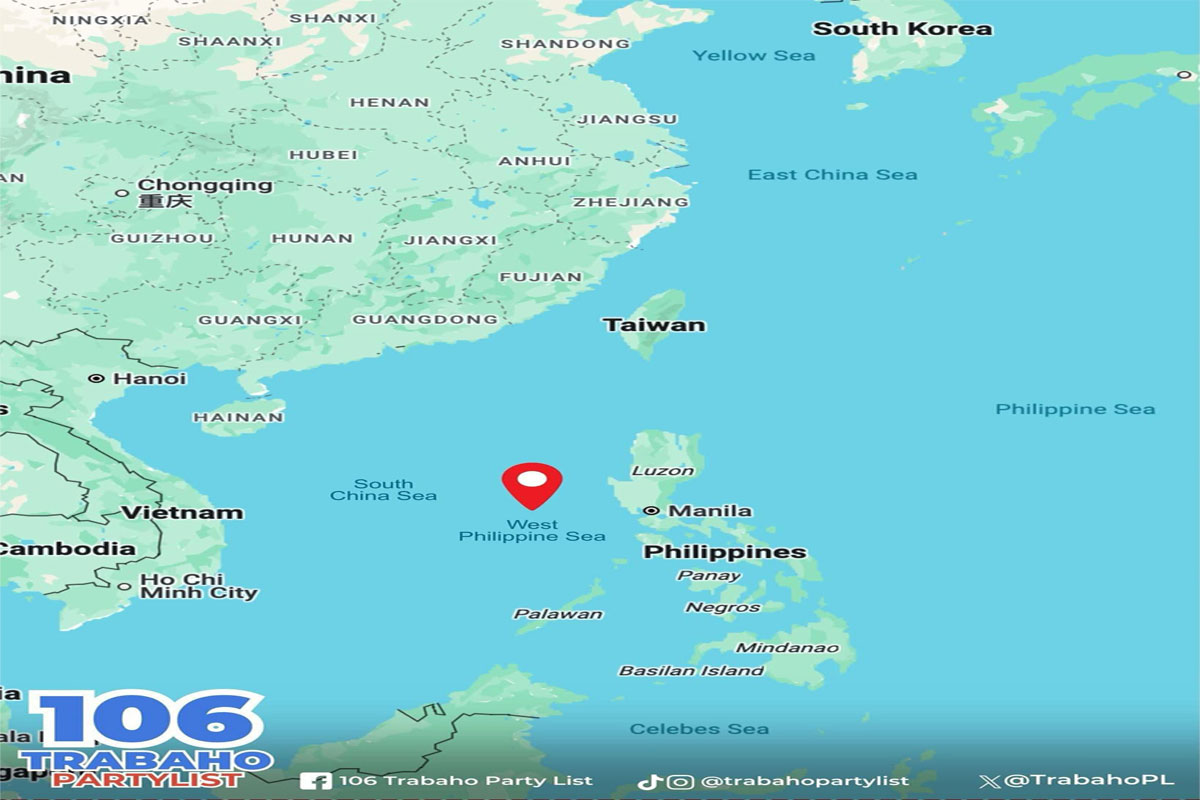
Villafuerte pushes revival of textile industry
To restore PHL as major clothing exporter
CAMARINES Sur Rep. LRay Villafuerte is pushing the revival of our garment and textile industry, once a premier dollar earner, as part of a major effort by the Marcos administration to scale up Philippine exports and meet its targets for overseas shipments.
Villafuerte said: “The DTI (Department of Trade and Industry) and BOI (Board of Investments) along with other concerned agencies need to work overtime with the private sector in revisiting the garment and textile industry roadmap under the PEDP (Philippine Export Development Plan) of the Marcos administration, with an eye to invigorating the clothing and apparel business—and reestablishing the Philippines’ presence in the world market as a major producer and exporter of these goods.”
“The government must take decisive steps to help this once sunshine $3-billion industry regain its footing, and revive the Philippines’ premier position in the lucrative global market, especially at this time when investors and enterprises are leaving No. 1 world garments producer and exporter China and relocating their businesses to our Asian neighbors like Vietnam and India,” said Villafuerte, who was a thriving entrepreneur in the export business before entering electoral politics two decades ago.
He said the roadmap for higher and inclusive growth for this sector under the PEDP should be revisited leading to its quick revival, “to sharpen anew our erstwhile global competitiveness in this business and entice foreign investors now leaving China to consider the Philippines as an ideal place in the region to relocate to and set up shop in.”
For starters, he said the Marcos administration should seriously consider the proposal of local industry players for the government to facilitate the construction of new textile factories, ahead of the anticipated increase in demand as soon as the Philippines forges a free trade agreement (FTA) with the European Union (EU) on apparel and other similar goods.
Villafuerte pointed out that Robert Young—the president of the Foreign Buyers Association of the Philippines (FOBAP) and trustee for the textile and fabric sector at the Philippine Exporters Confederation (PhilExport)—was reported last week as saying that his group has requested the government to build a pilot commercial-scale wearable textile factory, as a way to encourage foreign investors to similarly put up factories producing local fabric for exportable goods.
Villafuerte likewise asked the government to look into the FOBAP request for Manila to make a formal request to the EU to let the Philippines use imported raw materials while qualifying for zero duties as this proposed facility is still being built.
Young was quoted in a statement as saying that: “Just one (wearable textile factory) will be enough; We have to quickly start something so that these foreign investors will follow suit.”
Our garment exports are currently subjected to a tariff of 12% or higher because the Philippines is currently not a beneficiary of the EU’s Generalized Scheme of Preferences (GSP) system, according to Young. “They (EU) prefer that the fabric we will be using will be sourced from the Philippines. So, this is one way of saying the Philippines has to produce its own fabric.”
Villafuerte said that Young has stressed that a pilot factory to produce local fabric or textile is really necessary because the EU is likely to prescribe the same requirement for the use of locally produced raw materials in the renewed FTA negotiations.
The congressman said that, “One doable step for the government to meet its PEDP targets on export volumes and earnings amid global challenges like weaker global growth and demand is to invigorate sectors that were once major exporters and dollar earners, such as the garment and textile industry that used to be a $3-billion business for the country.”
Carrying out intervention programs to level up the production of exportable products and sharpening anew the once competitive edge of local garment and textile manufacturers would enable the government, he said, to pitch the Philippines as a better option for relocating their China-based operations to, in lieu of places like Vietnam, India, India or Bangladesh.
Bianca Pearl Sykmite, who is director of the DTI’s Export Marketing Bureau and executive director of the Export Development Council (EDC), has told the media of the possible “recalibration” of official targets set in the PEDP owing to slower growth of the global economy.
“We might temper them (export targets) because when we were drafting the PEDP, at the time we were recovering from the pandemic, there was an upward trend,” she said, citing challenges to industry growth like inflation, and the geopolitical crisis.
Last year, exports totaled $103.6 billion, or 18.3% below the PEDP target of $126.8 billion.
The value of garment exports from the Philippines slipped a hefty 70% from P115.7 billion in 2000 to P34.4 billion in 2022.
Citing a report by the University of the Philippines’ Institute for Small-Scale Industries (UP-ISSI), Villafuerte said that save for the revenue decline over the 2020-2022 period as a result of the pandemic, the world’s apparel market has been on the rise, with total revenue projected at $1.74 trillion and a yearly growth of 2.84% to hit a value of $2 trillion in 2027.
The combined revenue of the two biggest players in the global apparel market—China and the United States (US)—account for 45% of global earnings, and four other countries—Japan, India, the United Kingdom (UK) and Germany—account for a combined 20% share.
China was the top exporter-country in the world, followed by the EU, and the combined exports of both represented 68% of the world’s total in 2019. The next biggest exporters were Bangladesh, Vietnam, India, Turkey, Indonesia and Cambodia.
Bangladesh, Vietnam, India and Indonesia are projected to rise as major garments suppliers because of their lower labor costs, access to raw materials, skilled workforce, government support and favorable trade agreements, according to the UP-ISSI report.
This report said that along with extreme weather, Russia’s invasion of Ukraine has disrupted trade routes and triggered an energy crisis that have impacted the industry, affecting supply chains and availability of raw materials in Asia.
The UP-ISSI report said the Philippines has a strong base of skilled and semi-skilled workers that makes it an attractive destination for textile and garment production, but the industry “continues to struggle fighting off gradual decline due to lack of competitiveness.”
Local garment firms are struggling against other Asian garment companies, said the report, because our enterprises have not been as competitive in terms of wages, pricing, quality and delivery of export garments.
Based on the report, Villafuerte noted that local firms are focused on one aspect of garment production like assembly or the cutting and sewing of garments using imported materials, instead of doing all stages of production, which is the practice of other Asian garment firms.
Investors prefer investing in countries where all the stages of garment production are done by one firm.
Hence, the report said, the Philippines “has not been an attractive manufacturing site which was further aggravated by its low labour productivity.”
The website Asia Garment Hub, meanwhile, has identified the Philippines as one of the region’s 10 major producers of garments, textiles and footwear, generating $1 billion-worth of annual exports annually from about 200 manufacturers and over 1,000 subcontractors that employ over 405,000 workers.
It said that the pandemic has “heavily impacted” Philippine garment and textile exports, leading to business closures and job and income losses for workers.
Also, despite the roadmap launched by the government in 2020 to drive the industry’s recovery and its resurgence as a competitive player in the world, it said, “the sector continues to face ongoing challenges related to international competitiveness and aligning industry policies and practices with wider international labor standards.”
Starting out as a cottage-type industry in the 1950s, the website Trade Chakra said this sector expanded as a non-traditional export business generating revenue of $36 million in 1970 to $1 billion in 1987 and $3 billion in 2000.
Villafuerte noted that many companies have previously opted to outsource to China because of its young labor force, cheap labor, strong government support like tax breaks and subsidies to attract foreign investors, good transport infrastructure, and a robust technology sector behind new manufacturing technologies.
Because of these positive factors, China has transformed into a prime hub for manufacturing in assorted products, including clothing.
However, many of those outsourcing their businesses to China are now looking to relocate or have started moving their operations elsewhere, owing to factors such as rising labor costs, the trade war between that country and the US, and supply chain disruptions that saddled China during the pandemic.
Villafuerte pointed out that unlike the Philippines, countries like Vietnam, India, Mexico, Indonesia and Bangladesh have capitalized on China’s challenges as a chance to attract to their shores the manufacturing companies heading for the exit.
Amid the US-China trade war, several American fashion companies have stopped relying on China as their top supplier, owing to concerns over forced labor and the ensuing diplomatic uncertainty, he said.
According to a survey by the US Fashion Industry Association and Sheng Lu, an associate professor of fashion and apparel studies at the University of Delaware, the number of firms that have stopped tapping China as their main supplier has fallen to 61% from the pre-pandemic level of 30%.
About 80% of these firms are thinking of reducing their sourcing from China over the next two years, according to the same study, in favor of suppliers like Vietnam, Bangladesh and India that have large-scale production capacities and relatively more stable economic and political conditions.
The CNBC Supply Chain Heat Map indicated that China has been losing its manufacturing businesses to Vietnam, Malaysia, Bangladesh, India and Taiwan, as reflected in declining exports of apparel, footwear, travel goods and handbags, among others.
The Japanese Chamber of Commerce and Industry of the Philippines Inc. (JCCIPI) said that Japanese companies that want to leave China are considering their relocation to Vietnam, Indonesia and Thailand because of supply chain, resources, and raw material production.



















